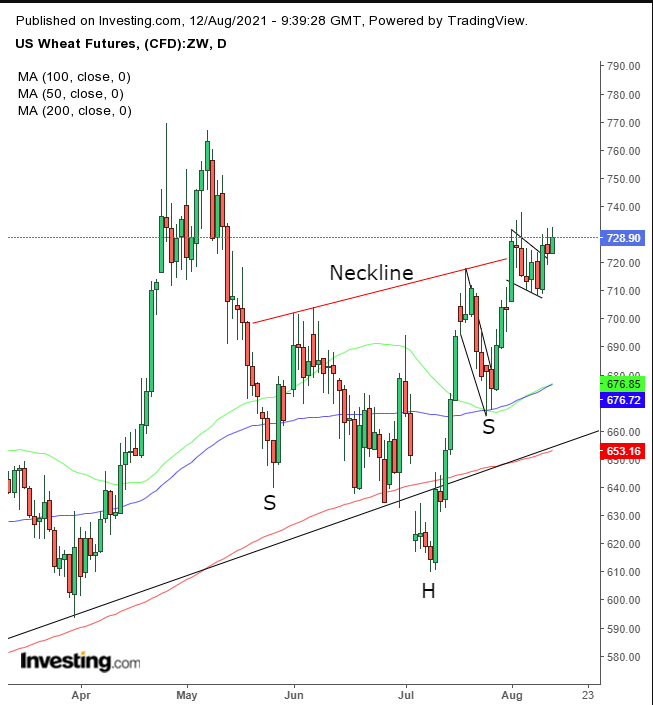Irregular weather has been weighing on wheat, limiting global crop yields. Russia’s winter wheat output was low, and the harvest in North American was curtailed by drought. Too much rain, including flooding, damaged Europe's crop yield.
As such, traders are eyeing today's release of the USDA’s World Agricultural Supply and Demand Estimates (WASDE), which will take place at noon EDT. The monthly report provides "annual forecasts for supply and use of U.S. and world wheat," among other agricultural commodities. It often serves as a catalyst for an ag commodity's next big move.
Given current fundamental conditions and technicals, we’re betting the next move for wheat futures will be higher.

The contract completed a second consecutive falling flag, a range created when lucky bulls who bought the dip since the July low decided to take profit. Given that exiting a position involves a sale, it requires an opposing position, a buy, to be initiated as well. That sudden oversupply—as early bulls all cashed out weighs on the price and new hopefuls jumped in—gave the flag its downward bias.
However, the crowded trade demonstrates ample demand exists to pick up the slack, presumably, by new bulls.
Traders generally avoid “chasing the price,” since they don’t know when it will suddenly whipsaw and stop them out. So they wait for a dip, which is what this flag indicates. The upside breakout demonstrates that new bulls absorbed all the available supply within the flag and were willing to increase their bids to find new willing sellers at higher prices.
The upside breakout of the range is expected to stir up momentum amid a market chain reaction, including short covers and triggered longs, which are likely to attract additional speculation, propping up the price yet further.
Notice how the first flag established the neckline of a H&S bottom and the second flag—right on the neckline—is providing the market mechanism that will break through the neckline. A H&S bottom is the pattern that develops when satisfied, tired traders cash out, enabling hungry, energetic new traders to buy in, thereby extending the uptrend as indicated by the uptrend line and reinforced by the 200-DMA. At the same time, the 50- and 100-DMAs intertwine to join forces and support the right shoulder.
Trading Strategies – Long Position Setup
Conservative traders should wait for a decisive, obvious breakout, which would likely find resistance by the April-May highs, creating a return move, which should jump off the neckline, indicating ongoing demand.
Moderate traders would wait for the same breakout and dip, for a better entry, if not for additional confirmation.
Aggressive traders could enter a long position at will, provided they understand there's the possibility of a bull trap. Therefore, they absolutely must trade according to a coherent plan. Here is an example:
Trade Sample
- Entry: $725
- Stop-Loss: $720
- Risk: $5
- Target: $760
- Reward: $35
- Risk:Reward Ratio: 1:7
Author's Note: The above is just a sample and not the actual analysis. That’s in the body of the article. If you did not read and understand the post, then don't make the trade. The term 'sample,' above, suggests it's just one way to approach this trade. We're not prophets and can't know what will happen. Plus, trading is nothing more than luck management by statistically analyzing supply, demand and previous results under similar circumstances. The goal is to get on the side of statistics and win in the long run, not on a trade-by-trade basis. You need to develop your own trading style and write a plan that incorporates your budget, timing and temperament. Until you do so, you may use our samples in the hopes of learning, not profit. Or you will end up with neither. We guarantee it. And you won't get your money back, snide comments notwithstanding.
